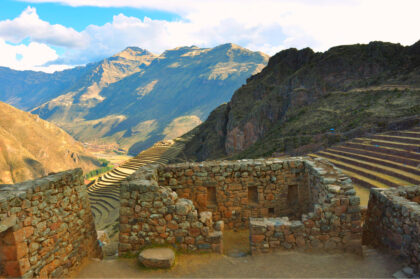My recent trip to Peru offered a lot of gifts, and I’ll hopefully be unpacking a lot of them with you over the coming weeks and months. Right now, I’m thinking about how much we are able to know about some ancient structures just by the foundations that remain.
“Why do you suppose the Incans chose to build this here, in this place?” my guides would ask. Maybe it was practical. Plenty of water. Soil for growing crops. Stone for building materials. But there were spiritual reasons as well.
A reverence for the sun and for the earth guided a lot of Incan decisions about what qualified as a sacred site. Gratitude for—and partnership with—the natural world were spiritual foundations that preceded the physical foundations of their sacred structures.
After centuries, those physical foundations remain, though many of the structures they supported have been destroyed or built over. The spiritual foundations remain among many people as well. Some specific practices have evolved, but those practices are still built on familiar values dating back to the earliest expressions of their spiritual identities.
Over the next several months, we’re going to hear more about proposed changes to Article II of the Unitarian Universalist Association Bylaws. Many of you have already participated in some online feedback sessions hosted by the group responsible for evaluating this intentionally fluid article of our bylaws. Article II is the section that contains our first Seven Principles, as adopted in 1985. (That date is right. Our Principles are not a centuries-old foundation, but a mere 37 years old.)
Although it’s tempting to frame our current principles as a kind of creed that defines our faith, the principles were always intended to be evolving. UUs maintain that revelation is not sealed. We’re never done learning and growing.
Rather than a creed, we have a covenant. And meaningful covenants are usually about the mutual promises of specific people at a specific point in their journey. “We covenant together to affirm and promote” the principles we share. Maybe the wording of our principles can make them seem like noble ideals rather than calls to action. The mutual promise that we make to one another to actively promote these principles in the world can be easy to forget.
But there is a foundation under the structure of our principles. Even though our principles were intended to be reevaluated and revised over time, the foundation beneath them perhaps has greater longevity in defining our identity as a unique faith tradition.
The values we share as UUs form a deep foundation upon which a number of possible structures could be built. Our current principles were a good fit for a particular time in our story—a time that was visionary for people 37 years ago. Now we are exploring whether our next chapters—the part of our story that is visionary for us right now—might be better served by building a new structure on that solid foundation of our shared values.
Share this post:
